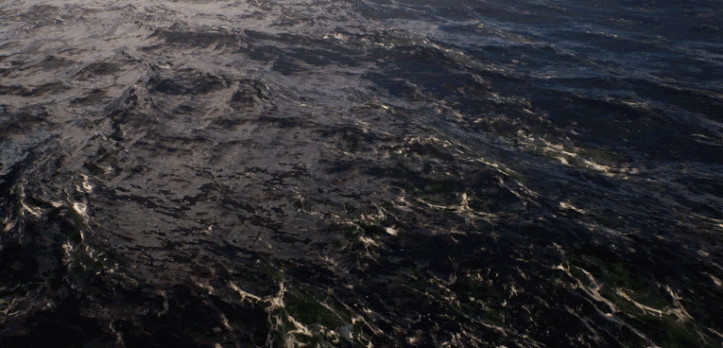NAME | TYPE | DESCRIPTION | USE IN GAMES |
Gerstner Waves | Analytical model | Uses sine-based equations to simulate realistic wave motion with directional control. Supports multiple octaves for complex surfaces. | Very efficient for real-time rendering. Common in stylized or moderately realistic water. |
Trochoidal Wave | Analytical model | Describes realistic particle paths (trochoids). Basis for Gerstner waves. | Theoretical basis for Gerstner; not used directly but informs accurate motion in simulations. |
Stokes Waves | Analytical model | Nonlinear model with asymmetric crests and troughs. More realistic than sine. | Rare in games directly; can enhance realism in stylized or cinematic water. |
Tessendorf Waves | Spectral / FFT-based | Uses inverse FFT to generate an ocean surface based on a frequency spectrum (e.g., Phillips or JONSWAP). Produces detailed, realistic ocean surfaces. | Used in AAA titles for large-scale oceans. Requires more GPU power but still feasible in real-time. |
JONSWAP Spectrum | Oceanographic spectrum | Describes the energy distribution in sea states, particularly in fetch-limited conditions. Enhances the realism of wave peaks over time. | Feeds into spectral models like Tessendorf to simulate stormy seas more accurately. |
Phillips Spectrum | Physical spectrum model | Based on wind direction and strength, defines wave energy per frequency and direction. Prone to instability near zero-frequency waves. | Base input for realistic wave generation in Tessendorf-style simulations. |
Directional Spectrum | Spectral Input | 2D spectrum with energy per direction. For realistic ocean behavior. | Enables more control in FFT-based oceans. Useful for tuning wind/wave direction in games. |
Boussinesq Waves | Simulation | Shallow water model with dispersion. Better near coastlines. | More accurate than SWE near shores. Great for realistic coastlines or flooding effects. |
Solitary Waves (Solitons) | Simulation | Stable, isolated wave pulses. Used for tsunamis or stylized FX. | Used in tsunami or special effects. Visually striking and stable shape. |
SPH (Smoothed Particle Hydrodynamics) | Particle-based simulation | Simulates water as particles that interact physically. Realistic but expensive. | Typically used in localized effects — splashes, fountains, or destruction moments. |
Shallow Water Equations (SWE) | Fluid simulation | Numerically solves equations for water behavior in shallow areas. Includes wave reflection, refraction, and interference. | Great for shores, rivers, and gameplay-driven wave interaction (boats, characters). |
Choppy Waves | Post-Processing Modifier | Adds crest sharpness to smooth FFT waves. Fake detail. | Adds visual detail to ocean waves. Often used as a modifier in FFT systems. |
Encino Waves | Proprietary hybrid | Likely a hybrid method (spectral + simulation) developed by Weta/Encino for cinematic water. | Rarely used directly, but techniques can inspire high-fidelity offline-to-real-time baking workflows. |
Capillary Waves | Surface tension waves | Tiny ripples caused by surface tension, not wind. Physically small, high-frequency waves. | Often faked or blended with normal maps to enhance detail close to the camera. |
FFT Ocean (Real-Time) | GPU-optimized spectral model | Real-time adaptation of Tessendorf using GPU shaders and compute buffers. | High-end games (e.g., Sea of Thieves) for dynamic oceans with performance in mind. |
Hybrid Models (e.g., Gerstner + Flow Maps) | Mixed techniques | Combines simple waveforms (Gerstner) with flow maps, deformation textures, or simulation data. | Balances performance and realism. Useful for game worlds with mixed water types (rivers, lakes, oceans). |
Wave Particles / Ripple Sim | Procedural Simulation | Ripples and interactions via spreading wave particles. | Used for localized ripple effects (footsteps, objects in water). Lightweight simulation. |
Capillary Waves | Detail Layer | Tiny surface-tension waves. Adds fine detail in normal maps. | Not simulated in real-time, but adds realism via detail textures or normals. |
Wave Particles / Ripple Sim | Procedural Simulation | Ripples and interactions via spreading wave particles. | Used for localized ripple effects (footsteps, objects in water). Lightweight simulation. |
Vertex Animation Textures (VAT) | Baked Animation | Pre-baked wave motion played via texture. Very efficient. | Used in mobile/VR or stylized games where real simulation is too heavy. |





